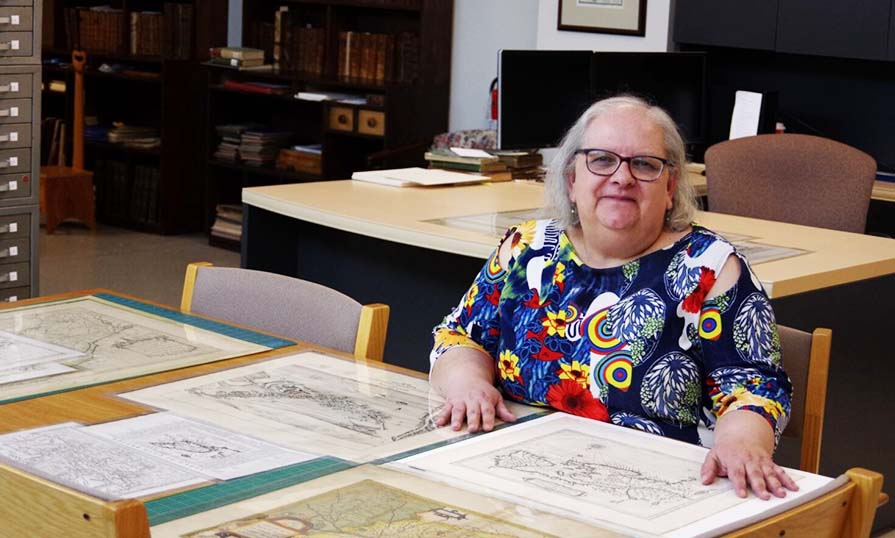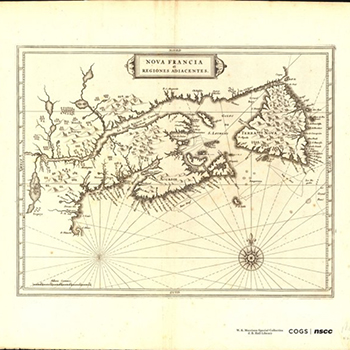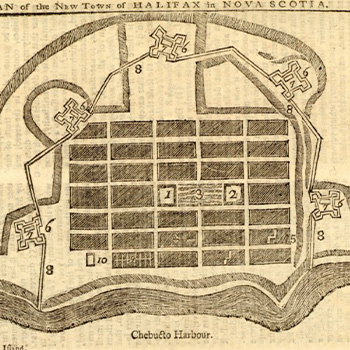Celebrating one of NSCC’s beloved librarians

From an early age, Trish LeBlanc wanted to be a Geologist. She was intrigued by natural science and the process in which the Earth changes over time. After high school, she pursued a post-secondary education in Geology and developed an interest in historical maps early in her career. Although she was on the pathway to a career that she was passionate about, she says that becoming a librarian was almost “a happy accident”. Trish went on to dedicate 14 years to a career as a librarian at NSCC’s Annapolis Valley Campus, overseeing the WK Morrison Special Collection at the Centre of Geographic Sciences. Trish retired from NSCC in June 2023 but remains at the College as a part-time librarian.
Trish’s career pathway from Geologist to Librarian
After high school, Trish went to Saint Mary’s University and completed a Bachelor of Science in Geology. She went on to work at the Nova Scotia Department of Natural Resources (DNR) who were automating their library and wanted a Geologist to describe the collection. It was while at DNR that Trish was first exposed to working with historical map collections.
After working at DNR, Trish was deciding between pursuing a Masters in Geology or a Master of Library and Information Studies at Dalhousie University. “Part of me wanted to continue in geology, but I enjoyed the library work. I applied to both on the same day and thought whoever gets back to me first, that’s what I’ll do. The School of Library and Information Studies responded first and I never looked back or regretted that choice,” she says.

Developing a passion for historical maps
When Trish heard Annapolis Valley Campus was looking to hire a Librarian, she applied and was hired. Part of her role was to work with one of Canada’s most historical and valuable map collections. “The WK Morrison Special Collection - a mixed media print collection of historical maps, atlases, periodicals and books - is incredibly valuable, not only as a resource for students, but also in its monetary value and interest to the wider community.” She says that while she had an interest in historical maps from early in her career, she developed a passion for them through that work.
Early mapping of Nova Scotia
According to Trish, the Collection is unique in the province in terms of its focus on the early mapping of Nova Scotia and specifically the 18th century nautical charts of J.F.W. DesBarres’ Atlantic Neptune. “The collection also contains a complete run of the Gentleman’s Magazine from 1731-1802, and other early European periodicals containing maps not present in other collections.” Trish says that in addition to the maps that cover the advances in geographic knowledge over 5 centuries, there are important atlases dating from the 18th and 19th centuries as well as an interesting collection from the 19th and early 20th centuries.

Building a unique and valuable collection of historical maps
Trish says the majority of the Collection (just over 2,000 items) came from Walter Morrison who taught cartography (the science or practice of drawing maps) at the Nova Scotia Land Survey Institute (NSLSI, predecessor of COGS) from 1966-1985. The other parts of the Collection were donated by Leslie B. Marcus who collected historical maps of South America, and David Raymond who studied cartography at NSLSI under Walter Morrison. David caught the collecting bug from Walter and also taught cartography / Geographic Information Systems (GIS) at COGS from 1985-2013.
As a cartographer and a collector, Walter saw the value of using antique maps in teaching cartography. With no immediate family, he started to donate his collection to COGS in 2002. When he passed away in 2011, he left the remainder of his collection to COGS as well as the proceeds of the liquidation of his estate in a trust to conserve and protect it as a special collection.
“When Walter passed, the map collection became part of my responsibility in a more formal way, which I was more than keen to take on,” says Trish.
The Leslie Marcus collection was donated to COGS in 2016. According to Trish, Leslie taught romance languages at University of New Brunswick and retired to Annapolis Royal. “As he was getting older and thinking about who to leave his collection to, he was passing COGS one day, looked at the name and thought, I wonder if they would want my collection? He contacted us and to my surprise, all but 2 of his maps were unique to our existing collection,” explains Trish.
David Raymond started donating his collection in 2018. “It was almost natural, given he studied under Walter and was friends with him, that he would donate his collection to us.”
The most interesting pieces of the collection
Trish says that every map tells a story and she tries to connect that story with a person’s interest. She says that locals from the Valley are most interested in local maps, especially the Bird’s Eye View of Annapolis Royal and Granville but that in general, there are a few that everyone finds interesting:
- The oldest map in the collection is a 1545 map of the eastern Mediterranean.
- The newest map in the collection is a 1961 orbital chart that was carried into space by John Glenn in the first US manned orbital flight.
- The first widely published plan of Halifax from 1749
- The oldest map of Atlantic Canada is from 1630, only 25 years after the founding of Port Royal.
- Online, the most viewed item is an 1878 Atlas of the Maritimes
Trish says, “Without question, the most enjoyable part of my 14 years with NSCC is working with the Morrison Collection”. She adds that the most rewarding part is seeing the impact that the Collection has on individual students and seeing their growth and success. Trish retired from NSCC in June 2023 after a 14-year career.

